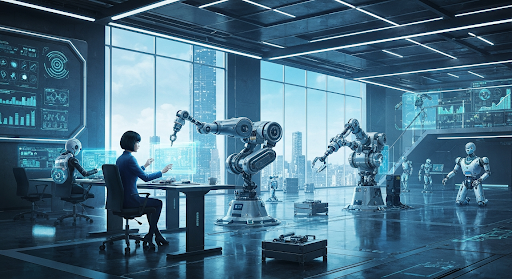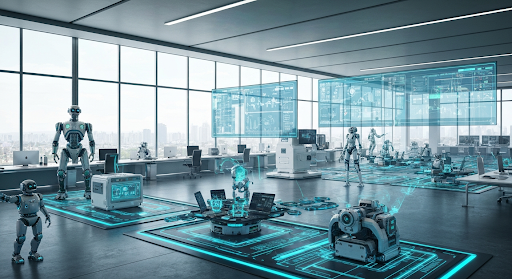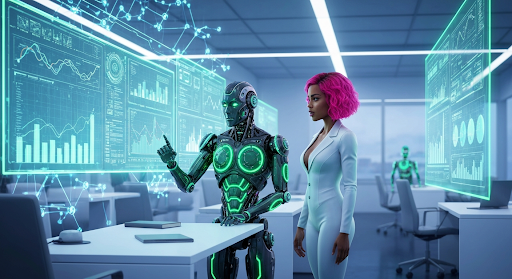How Robots Automation is Transforming Industries Worldwide
Key Highlights
- Robotics and automation are revolutionizing industries by enhancing efficiency, safety, and precision in both physical and digital environments.
- Robots, as programmable machines, are increasingly used in manufacturing, logistics, and service sectors for repetitive and hazardous tasks.
- Automation technology now includes not just physical robots but also software robots such as Robotic Process Automation (RPA) for business processes.
- Collaborative robots (cobots) are emerging to work alongside humans, boosting productivity and flexibility in industrial settings.
- The evolution of automation systems is driven by artificial intelligence, machine learning, and cognitive automation, making industries more adaptive and competitive.
- Industry-specific impacts include improved product quality, streamlined logistics, and new job opportunities, while also introducing fresh challenges for workforce adaptation.
Introduction
Across the globe, robot automation is fundamentally changing how industries operate. As companies embrace digital transformation, automation technology is reshaping everything from factories to financial services. This shift means machines and computer software are increasingly handling tasks that once required human effort. Businesses are leveraging automation not just for efficiency, but to gain a competitive edge, improve safety, and tackle labor shortages. Let’s explore how robotics and automation technology are woven into the fabric of industry, powering smarter, faster, and more resilient operations.
Understanding Robotics and Automation in Modern Industries
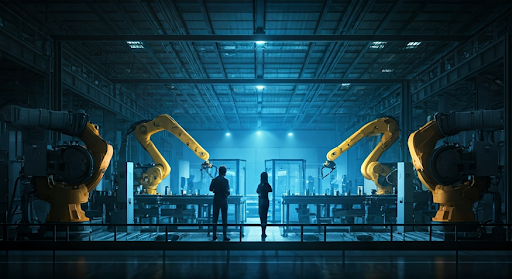
Industries today are blending robotics and automation technology to optimize operations in both the physical and digital worlds. Robotics involves designing and programming machines capable of performing tasks autonomously or with minimal human involvement. These programmable machines, often enhanced with artificial intelligence and computer vision, can transform routine tasks and adapt to complex environments.
Automation, on the other hand, focuses on making processes more efficient by using technology—either physical devices or software systems—to carry out repetitive or labor-intensive work. Together, robotics and automation technology help companies minimize human error, lower costs, and accelerate production, answering the question: “Can you explain the main differences between robotics and automation, and how they are used in industry?” The next sections break down these differences and look at their unique uses.
Defining Robotics: What Makes a Machine a Robot?
To understand robotics, start with the basics: A robot is a programmable machine designed to interact with the physical world. Unlike traditional automated machines, robots integrate advanced technologies such as artificial intelligence, computer vision, and sensors, enabling them to make decisions and adapt to their environment. They can handle tasks ranging from assembling cars to vacuuming your living room, operating either autonomously or under human supervision.
What truly sets robotics apart is flexibility. Robots can be reprogrammed for various duties, unlike fixed automation machines that are limited to specific tasks. Their ability to sense, process, and act means robots excel in environments where precision, adaptability, and speed are crucial. For example, industrial robots in manufacturing can switch from welding to painting simply by updating their programming.
In industry, robots are more than just tools—they are intelligent assistants. They can work around the clock without fatigue, reducing human error and improving product quality. According to Alex Owen-Hill, “Robots are programmable machines that can complete tasks autonomously or semi-autonomously,” making them invaluable in any modern production environment.
Distinguishing Automation from Robotics: Key Differences and Overlaps
While robotics is a subset of automation, not all automation involves robots. Automation is the broader concept, encompassing any use of technology to perform tasks with minimal human intervention. This can involve software robots automating digital work, control systems managing machinery, or even building control systems like automated lighting.
Key differences and overlaps include:
- Automation can involve both physical (industrial) and virtual (software) processes, while robotics specifically refers to programmable machines operating in the physical world.
- Software robots (RPA) automate repetitive business tasks in offices, whereas physical robots handle material handling or assembly on production lines.
- Types of automation include fixed (repetitive, unchanging tasks), programmable (can be updated for new tasks), and flexible (adapts quickly to new demands).
- Human intervention varies: Some automation needs constant human oversight; advanced robotics, powered by artificial intelligence, needs little or none.
In practice, industries often combine both. For example, in automotive manufacturing, robots assemble components while automation software manages inventory and workflow behind the scenes. Understanding these distinctions helps businesses choose the right mix of technologies for their needs.
The Evolution of Robots and Automation Technologies
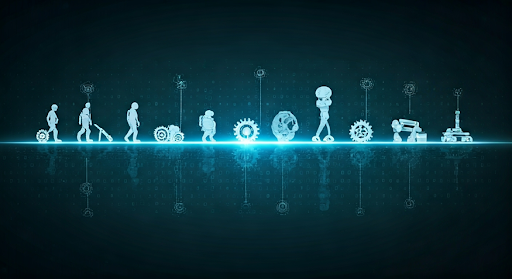
The path of automation systems and robotics has been shaped by decades of innovation in computer science, engineering, and advanced technologies. Early automation was mechanical and simple, but the integration of digital controls, machine learning, and artificial intelligence has driven remarkable progress. Today, manufacturers depend on robots and automation technology to manage everything from routine assembly to complex, data-driven decision-making.
This evolution is ongoing, with next-generation systems promising even greater adaptability and intelligence. The following sections cover major milestones in the history of industrial automation and reveal the trends shaping the future of robotics.
Milestones in Industrial Automation History
Industrial automation has come a long way since its beginnings. Early milestones focused on mechanization—using machines to boost human labor—then shifted to automation systems that removed the need for direct human control. The introduction of robots brought greater flexibility, precision, and productivity to industries like automotive manufacturing.
To better understand this evolution, here’s a text table highlighting key milestones:
| Milestone/Period | Description |
|---|---|
| Early 1900s | Mechanized assembly lines reduce manual labor |
| 1961 | First industrial robot (Unimate) installed at GM Plant |
| 1970s-80s | Widespread use of programmable logic controllers (PLCs) |
| 1990s | Integration of computer vision and sensors in robotics |
| 2000s | Rise of flexible automation and collaborative robots |
| 2010s-present | AI-powered robots and cognitive automation emerge |
These advances have enabled production lines to run faster, safer, and with fewer errors, transforming how human workers engage with technology on the factory floor.
Current Trends Shaping Robotics and Automation
Modern robotics and automation are being transformed by a series of powerful trends. The digital transformation of industries is driving the adoption of smarter, more connected automation systems fueled by artificial intelligence and machine learning.
Some of today’s most significant trends include:
- Cognitive automation: Intelligent automation systems use AI to adapt in real time, making decisions and optimizing operations without human intervention.
- Collaborative robots (cobots): Cobots work safely alongside humans, providing flexibility and bridging the gap between manual labor and full automation.
- Expansion beyond manufacturing: Industries like healthcare, agriculture, and services are increasingly using robots for complex tasks, from surgery to food production.
- Machine learning integration: Robots now learn from data and experience, improving over time to deliver better outcomes.
These trends are making it possible for businesses to automate more challenging tasks, increase efficiency, and remain competitive in an ever-evolving landscape.
Robotic Process Automation (RPA) and Its Business Applications
Robotic process automation (RPA) leverages automation software to streamline business processes, significantly enhancing efficiency and reducing human error. By deploying RPA tools, organizations can automate repetitive tasks previously reliant on human workers, allowing them to focus on complex tasks that require creativity and human intelligence. Use cases span across various sectors, including financial services and industrial automation, where RPA software optimizes productivity and accelerates digital transformation, creating a competitive edge and facilitating intelligent automation within the workplace.
How RPA Works: Features and Functionality
RPA operates by mimicking human actions in virtual environments. These software robots, or RPA bots, interact with digital systems just as a person would—clicking, typing, copying, and pasting information across platforms. The beauty of RPA is its ability to automate routine business processes without the need for deep changes to existing IT infrastructure.
Key features and functionality include:
- Rule-based automation: RPA bots follow predefined instructions to carry out repetitive digital tasks, such as invoice processing or scheduling.
- No-code/low-code tools: Many RPA platforms allow users to build bots without extensive programming knowledge.
- Scalability: Bots can be easily duplicated to handle larger workloads or new business processes.
- Seamless integration: RPA works across different applications, bringing together data from separate systems for unified automation.
In business environments, RPA improves efficiency, maintains compliance, and delivers quick returns on investment by reducing manual errors and labor costs.
Leading Software Platforms for RPA Implementation
When it comes to implementing RPA, several leading software solutions stand out for their capabilities, ease of use, and support for business process automation. These tools help organizations design, deploy, and manage RPA bots, making automation accessible even to non-technical users.
Prominent RPA platforms include:
- UiPath: Renowned for its intuitive interface and extensive automation library, UiPath is widely used in industries ranging from finance to healthcare.
- Blue Prism: Blue Prism offers robust process automation with a focus on security and compliance, ideal for highly regulated sectors.
- Automation Anywhere: This platform stands out for integrating cognitive automation and machine learning, allowing businesses to automate more complex processes.
- Microsoft Power Automate: Known for its easy integration with Microsoft’s suite of products, this tool is popular for automating tasks within the Microsoft ecosystem.
Each platform assists organizations in streamlining processes, improving accuracy, and scaling automation initiatives across departments.
Industry-Specific Impacts of Robots and Automation
The use of robots and automation is having profound effects across different industries. In manufacturing, logistics, and warehousing, physical robots and advanced automation systems are driving efficiency and reducing operational costs. These technologies help companies respond to labor shortages and maintain high standards of product quality.
Meanwhile, sectors like healthcare, agriculture, and customer service are also leveraging automation to streamline workflows and improve outcomes. The next sections showcase real-world use cases and highlight the benefits of both traditional and collaborative robots in industry settings.
Manufacturing, Warehousing, and Logistics: Use Cases and Benefits
Manufacturing, warehousing, and logistics are at the forefront of robot automation adoption. In these environments, industrial robots and automated systems handle tasks such as assembly, packaging, and quality control with speed and precision. This transition not only improves productivity but also enhances workplace safety by taking on hazardous or repetitive work.
Common use cases and benefits include:
- Automated guided vehicles (AGVs): These robots move goods around warehouses, reducing the need for manual labor.
- Robotic picking and packing: Automation speeds up order fulfillment and minimizes human error.
- Palletizing and material handling: Robots stack and transport products efficiently, supporting high-volume operations.
- Inspection and quality assurance: Machine vision systems catch defects early, improving product standards.
By adopting these solutions, businesses in logistics and manufacturing gain a competitive edge, react quickly to market changes, and optimize their entire supply chain.
Collaborative Robots vs. Traditional Industrial Robots
Collaborative robots, or cobots, represent a major evolution in industrial robotics. Unlike traditional industrial robots, which typically operate in isolated zones for safety, cobots are designed to work alongside human employees without barriers. They combine advanced sensors, intelligent automation, and sophisticated control systems to ensure human safety and seamless cooperation.
Key differences and advantages include:
- Safety features: Cobots have force-limiting technology and sensors to avoid collisions, making them safe for direct interaction.
- Ease of programming: Cobots often feature intuitive, user-friendly interfaces, allowing non-experts to reprogram them quickly.
- Flexibility: Cobots can be redeployed for different tasks, supporting small-batch production and frequent changeovers.
- Human intelligence integration: Cobots complement human skills, enabling teams to tackle complex or delicate operations together.
By bridging the gap between full automation and manual labor, cobots are expanding the reach of robot automation into new areas, enhancing productivity without sacrificing workplace safety.
Conclusion
In conclusion, the transformative power of robotics and automation cannot be overstated. These technologies are reshaping industries by enhancing efficiency, reducing costs, and driving innovation. As businesses increasingly adopt robotic solutions, understanding their applications and impacts becomes crucial for staying competitive. From manufacturing to logistics, the integration of robots offers significant advantages, including improved productivity and safety. Embracing these changes is essential not only for organizational growth but also for adapting to the future of work. If you’re eager to explore how robotics can benefit your business, don’t hesitate to get a free consultation to discuss tailored solutions.
Frequently Asked Questions
What are the main challenges when implementing robots and automation?
Implementing industrial automation can be challenging due to upfront investment costs, integration complexities, and potential disruptions to existing workflows. Issues such as human error during setup, adapting processes to work with advanced technologies, and ensuring ongoing staff training are common hurdles for businesses embracing process automation.
How do robots and automation impact the workforce and job opportunities?
Robots and automation technology change workforce dynamics by shifting human workers from repetitive tasks to roles that require problem-solving and oversight. While some job roles may be replaced, cognitive automation and new positions in robot programming, maintenance, and process optimization are creating fresh opportunities for employees.
What strategies help businesses adopt robotics and automation successfully?
For successful adoption, businesses should analyze existing workflows with process mining to identify automation opportunities, invest in intelligent process automation and software solutions, and encourage ongoing staff training. Partnering with experienced vendors and leveraging years of experience in automation ensures a smoother transition and sustainable results.

